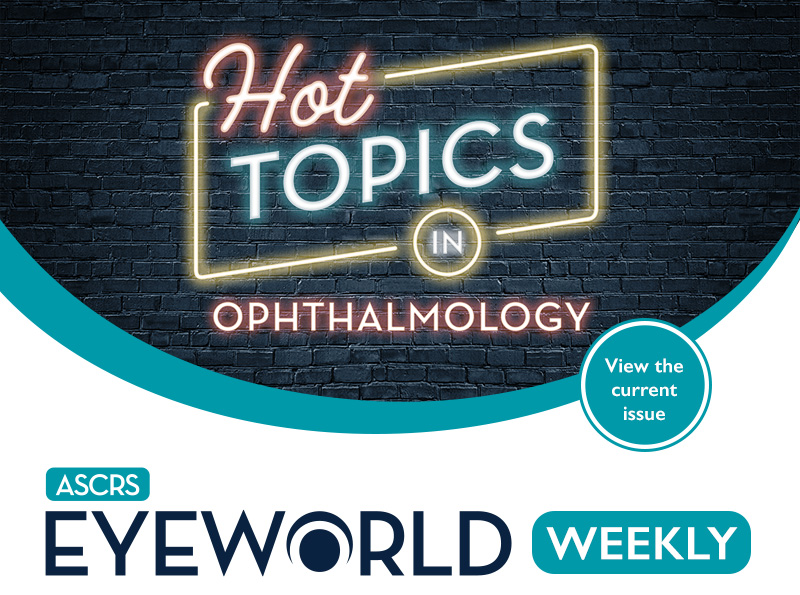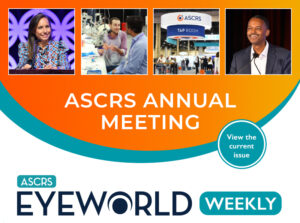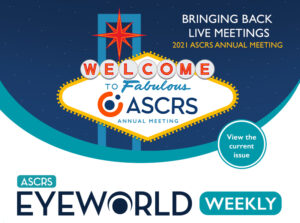
- Clinical trial for new cataract surgery technology
- Topline results from Phase 2 trial investigating treatment for persistent corneal epithelial defect
- Update on sustained-release glaucoma implant and Glaukos cornea programs
- First patient enrolled in Phase 3 trial for presbyopia drop
- ASCRS news and events
January 13, 2023 • Volume 29, Number 2
Clinical trial for new cataract surgery technology
Keranova announced the completion of its randomized, comparative, multicenter, pivotal trial that evaluated the use of the company’s FemtoMatrix technology, which the company described as “an ultra-fast robotized laser to treat cataract patients.” The study conducted in the Czech Republic enrolled 54 patients who received cataract surgery with the FemtoMatrix in one eye and traditional phacoemulsification in the second eye, which served as the control. The company’s press release stated that the FemtoMatrix technology was able to reduce or eliminate the use of ultrasound in the majority of cases. In a subpopulation, the press release continued, 20 patients with cataracts of grade 3 or more saw a 100% reduction in effective phacoemulsification time with the FemtoMatrix system. Two additional studies on 35 patients with cataracts grade 3 or higher also showed that FemtoMatrix reduced or eliminated the need for ultrasound (72% of cases were performed without ultrasound). Ten patients in these studies received ultrasound for an average effective ultrasound time of 2.3 seconds. According to the company’s press release, Keranova will seek the CE Mark for the technology this year.
Topline results from Phase 2 trial investigating treatment for persistent corneal epithelial defect
Amber Ophthalmics announced positive topline results from its Phase 2 trial evaluating two different concentrations of its treatment for persistent corneal epithelial defect caused by chemical or thermal injury. According to the company’s press release, patients in the trial were randomized to receive NEXAGON (lufepirsen ophthalmic gel) at a high concentration (n=12), low concentration (n=12), or vehicle (n=11). Of those in the treatment groups, 66.7% achieved epithelial recovery, according to the company, compared to 27.3% achieving healing with vehicle. A Phase 2/3 study is expected to begin enrolling patients this quarter.
Update on sustained-release glaucoma implant and Glaukos cornea programs
Glaukos has several updates on pipeline products from its programs. First, it announced positive results from its iDose TRexchange clinical trial, which exchanged the travoprost intraocular implant for patients who received one in the company’s Phase 2b clinical trial with a new iDose TR implant. According to the company’s press release, the insertion of the second iDose TR and removal of the original was safe and effective. The company also stated that the new implant demonstrated a favorable safety profile over 12 months. More specifically, the press release stated that “no subject in the exchange trial exhibited a greater than 30% endothelial cell loss over the extended evaluation period of more than five years on average.” The data from this exchange trial will be included in the company’s upcoming NDA submission to the FDA, expected within the first quarter of this year. Another update from the company included that patient enrollment has begun for the Phase 3 confirmatory trial for Epioxa, an epi-on crosslinking therapy for keratoconus. The company also announced positive topline results from its Phase 2a, in-human clinical trial for GLK-301 (iLution), a cream-based, transdermal formula applied to eyelids for treatment of signs and symptoms of dry eye disease. A Phase 2b clinical trial is expected to begin this year.
First patient enrolled in Phase 3 trial for presbyopia drop
Ocuphire Pharma announced that it has enrolled its first patient in its Phase 3 pivotal trial that will evaluate the safety and efficacy of Nyxol alone (phentolamine ophthalmic solution) and Nyxol with low-dose pilocarpine for temporary treatment of presbyopia. According to the company’s press release, the study will enroll 320 subjects and will be conducted in two stages. In stage 1, Nyxol will be compared to placebo. In stage 2, four treatment groups will be evaluated (Nyxol and low-dose pilocarpine, Nyxol and low-dose pilocarpine vehicle, placebo and low-dose pilocarpine, and placebo and low-dose pilocarpine vehicle). The company stated that a second Phase 3 trial and 1-year safety study will begin this year as well.
ASCRS news and events
- ASCRS Annual Meeting: Tier 1 registration pricing for the ASCRS Annual Meeting, May 5–8, 2023, in San Diego, California, ends later this month. Register now for the best value to attend the meeting.
- Annual Meeting submission opportunity: Three symposia at the ASCRS Annual Meeting are seeking video case submissions until February 1. Find more information here.
- EyeWorld roundtable: EyeWorld Chief Medical Editor Sumit “Sam” Garg, MD, led a roundtable on the topic of presbyopia-correcting drops. Watch the discussion here.
Research highlights
- The clinical performance of TECNIS Synergy (Johnson & Johnson Vision) multifocal IOL and AcrySof PanOptix Trifocal (Alcon) IOL were compared in a prospective, randomized, comparative study published in the Journal of Cataract & Refractive Surgery. The study enrolled 150 patients, 97 of whom received the Synergy (95 completed 3 months follow-up) and 53 received PanOptix (52 completed follow-up). Most patients in both groups achieved 20/25 or better CDVA (100% in the Synergy group and 96.2% in PanOptix) and DCNVA at 40 cm (88.4% and 75.0%) and 33 cm (78.9% vs. 51.9%). The authors concluded that the Synergy provided an extended range of vision and “better mesopic performance than the [PanOptix].”
- A systematic literature review published in the journal Clinical Ophthalmology sought to assess the “clinical, economic, and humanistic outcomes of MIGS and SLT.” According to the paper, out of 2,720 articles, 81 publications were included in the analysis with the majority assessing iStent or iStent inject (Glaukos) and OMNI Surgical System (Sight Sciences), and some studies on GATT, Kahook Dual Blade, Hydrus (Ivantis), XEN Gel Stent (Allergan), PreserFlo (Glaukos), and iTrack Microcatheter (Nova Eye Medical). The authors reported an IOP reduction of 13.7–31% at 6 months postop and 11.4–39% at 1 year postop compared to baseline among prospective studies in the analysis. The study found most adverse events to be transient and nonserious. The authors noted limited humanistic and economic data in the literature. With these findings the investigators concluded that there is “rationale for wider use of MIGS in mild-to-moderate [open angle glaucoma].”
Product news
- The IC-8 Apthera (AcuFocus) has begun a limited commercial launch, with the first patients receiving the small-aperture IOL in the U.S. this month.
- Harrow announced the availability of Fortisite, compounded tobramycin 1.5% and vancomycin 5% from the company’s 503B outsourcing facility ImprimisRx, for in-office use.
This issue of EyeWorld Weekly was edited by Stacy Jablonski, Liz Hillman, and Ellen Stodola.
EyeWorld Weekly (ISSN 1089-0319), a digital publication of the American Society of Cataract and Refractive Surgery (ASCRS), is published every Friday, distributed by email, and posted live on Friday.
Medical Editors: Sumit “Sam” Garg, MD, Chief Medical Editor, Mitchell Weikert, MD, Cataract Editor, Karolinne Rocha, MD, PhD, Refractive Editor, Julie Schallhorn, MD, Cornea Editor, Manjool Shah, MD, Glaucoma Editor
For sponsorship opportunities or membership information, contact: ASCRS • 12587 Fair Lakes Circle • Suite 348 • Fairfax, VA 22033 • Phone: 703-591-2220 • Fax: 703-591-0614 • Email: ascrs@ascrs.org
Mention of products or services in EyeWorld Weekly does not constitute an endorsement by ASCRS.
Click here to view our Legal Notice.
Copyright 2023, EyeWorld News Service. All rights reserved.



